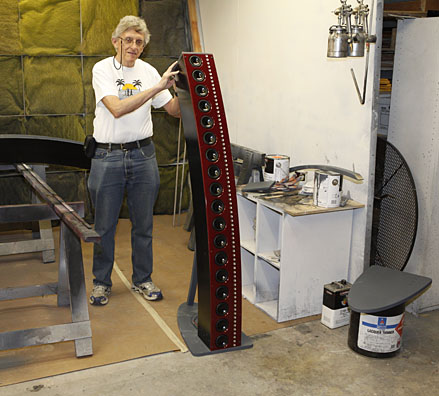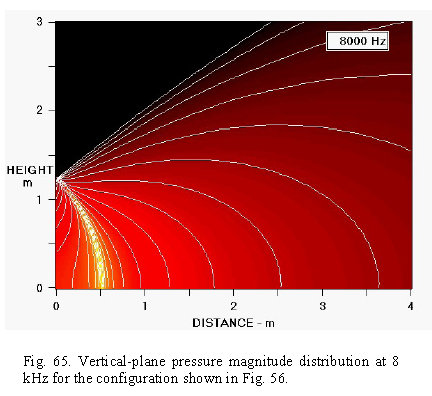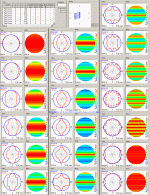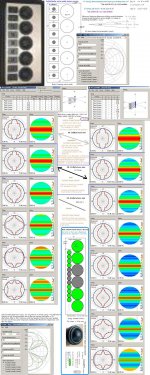Very interesting loudspeaker topology by Keels and Button. Look at the sims comparing vertical directivity which considers the floor reflections between point source, normal straight line array, and CBT array 
http://www.xlrtechs.com/dbkeele.com/PDF/Keele (2005-10 AES Preprint) - CBT Paper 5.pdf
Aside from the cost of buying large number of drivers, this looks very interesting. The large number of drivers must make for a very low distortion loudspeakers.


http://www.xlrtechs.com/dbkeele.com/PDF/Keele (2005-10 AES Preprint) - CBT Paper 5.pdf
Aside from the cost of buying large number of drivers, this looks very interesting. The large number of drivers must make for a very low distortion loudspeakers.


The design's novel in that it uses the same concepts as a Quad but applies them in the opposite manner. Wonder how the imaging changes relative to a linear array; degrading the degree of time alignment to increase the size of the sweet spot would normally make it worse. But if the floor's reflective enough to form a well balanced source it could end up projecting a phantom image from the center of curvature.
Five years old now and still not seen a product - I think that there is a reason for that. I've heard these small driver arrays and they all lack good sound quality. The directivity patterns don't resolve the problem that its a bunch of small inexpensive loudspeakers that sound like an AM radio.
Five years old now and still not seen a product - I think that there is a reason for that. I've heard these small driver arrays and they all lack good sound quality. The directivity patterns don't resolve the problem that its a bunch of small inexpensive loudspeakers that sound like an AM radio.
I have to agree.
A different angle would be what an array of 10 alpair5/6 or other good 2-3" drivers such as the Peerless ones...um these:
Peerless 830970, 2" Full Range 4 ohm from Madisound
however im sure it wouldnt be all that inexpensive, and surely in ALL these arrays, there comes a point when multiple driver masses/BL/Fs etc etc(which ARENT equal), only sum to give a more muddied transient response than a comparatively priced single FR driver...
Another line array using budget drivers, but the 50 budget drivers add-up to $645 US!
The Murphy Corner-Line-Array (MCLA) at True Audio:
The Murphy Corner-Line-Array Home Page
The Murphy Corner-Line-Array (MCLA) at True Audio:
The Murphy Corner-Line-Array Home Page
In his book Toole considers them line arrays best suited to surround duty.
Reason is that with correct radiation pattern you can have equal sound level between L and R surround independent from seating position. With regular speakers you lose envelopment quickly with off-centerline seating.
Havent tried yet this configuration, but maybe properly aimed, simple constant directivity speakers do the job too with less cost?
Reason is that with correct radiation pattern you can have equal sound level between L and R surround independent from seating position. With regular speakers you lose envelopment quickly with off-centerline seating.
Havent tried yet this configuration, but maybe properly aimed, simple constant directivity speakers do the job too with less cost?
Five years old now and still not seen a product - I think that there is a reason for that. I've heard these small driver arrays and they all lack good sound quality. The directivity patterns don't resolve the problem that its a bunch of small inexpensive loudspeakers that sound like an AM radio.
Earl,
It looks to me like Don is standing next to the product.
No doubt there is some equalization and crossover design to make the AM radio speakers sound good?
Expense doesn't necessarily define the quality of speaker drivers.
Cheers,
Dave.
Five years old now and still not seen a product - I think that there is a reason for that. I've heard these small driver arrays and they all lack good sound quality. <snip>
So what is this?
Sanctuary Series . SSE LA
21" tall, 4" wide, and 6" deep, comprising 8 drivers with group delay steering:
http://www.jblproservice.com/pdf/CBT/CBT50LA-WH.pdf
[Get BUSY, DIYers.... ]
]
http://www.jblproservice.com/pdf/CBT/CBT50LA-WH.pdf
[Get BUSY, DIYers....
Looking at the JBL speaker in the link, I tried something very similar a few months ago:
+ 8 x 3.3" drivers (Visaton FRS8, not exactly the cheapest at around 10 EUR)
+ narrow open baffle
I tried a lot of configurations including: all full range, power tapering, response shaping of the outer drivers (as in the JBL speakers above) and a super tweeter in the middle. The speaker measured quite good in terms of both FR(apart from comb filtering, of course) and polar response but...
...it just did not sound right.
Compared to my classic 2way (7" mid, 1"tweeter) open baffle panels, it was worlds away in all departmens. Yest, it sounded balanced as if the polar response was quite good, but my guess is that direct sound we hear in mid-highs counts a lot and that was not so good (possible drivers themselves + time differences)
I was hoping to have a more stable image as I heard it should be the case with line arrays and I am not the kind of listener that stays in a small spot. It was the other way round, scene collapsed quickly as I moved around a few inches.
Possible reasons for my failure:
+ line arrays are hard to get right - given the effort I put into this, I am not interested in wasting my time further to "get them right". Maybe it's me, though
+ maybe a full ceiling to floor array would be better - at this point, not willing to try
Overall, not my cup of tea and I wanted to share this with you guys: I am not saying it is not worth a try, but if you jump into it, be aware you might also be disappointed.
It looks like at least in a normal domestic environment, you can get better performance with less effort using a classical arrangement (woofer+tweeter)
My story refers exclusively to open baffle, so take it with a grain of salt. I remember MJK, I think, suggested once that an open baffle array would not be worth the effort and complexity: I give him right now.
PS: that JBL speaker seems to be designed rather for PA, not hi-fi. Clearly, for PA a line array would indeed do a terrific job.
HTH.
+ 8 x 3.3" drivers (Visaton FRS8, not exactly the cheapest at around 10 EUR)
+ narrow open baffle
I tried a lot of configurations including: all full range, power tapering, response shaping of the outer drivers (as in the JBL speakers above) and a super tweeter in the middle. The speaker measured quite good in terms of both FR(apart from comb filtering, of course) and polar response but...
...it just did not sound right.
Compared to my classic 2way (7" mid, 1"tweeter) open baffle panels, it was worlds away in all departmens. Yest, it sounded balanced as if the polar response was quite good, but my guess is that direct sound we hear in mid-highs counts a lot and that was not so good (possible drivers themselves + time differences)
I was hoping to have a more stable image as I heard it should be the case with line arrays and I am not the kind of listener that stays in a small spot. It was the other way round, scene collapsed quickly as I moved around a few inches.
Possible reasons for my failure:
+ line arrays are hard to get right - given the effort I put into this, I am not interested in wasting my time further to "get them right". Maybe it's me, though
+ maybe a full ceiling to floor array would be better - at this point, not willing to try
Overall, not my cup of tea and I wanted to share this with you guys: I am not saying it is not worth a try, but if you jump into it, be aware you might also be disappointed.
It looks like at least in a normal domestic environment, you can get better performance with less effort using a classical arrangement (woofer+tweeter)
My story refers exclusively to open baffle, so take it with a grain of salt. I remember MJK, I think, suggested once that an open baffle array would not be worth the effort and complexity: I give him right now.
PS: that JBL speaker seems to be designed rather for PA, not hi-fi. Clearly, for PA a line array would indeed do a terrific job.
HTH.
One more thing: my experience/comments above are related exclusively to arrays of fullrange drivers.
It might be very well that a well engineered multi-way array (proper separation distances between drivers according to the reproduced frequency) is vastly superior in terms of sound quality. But also more difficult and expensive to build.
It might be very well that a well engineered multi-way array (proper separation distances between drivers according to the reproduced frequency) is vastly superior in terms of sound quality. But also more difficult and expensive to build.
Array made right!
Have a look at the picture on the left please. That is a line array but not the curved type or open baffle or just midrange as it is from 80Hz-20kHz, -3dB at 80 and -0 at 20kHz. This speaker is as good as it gets in my experience. 14 amplifiers for just the speaker shown (1250 watts total for one speaker) and active control of the beam with this one a directivity index of 10 and THD of less than 0.1% at 100dB. And the sound... all say the same thing, a level of clarity and dynamics only heard on this speaker. Peak SPL from is 127dB from the one speaker shown.
Arrays are one of my personal goals however cheap attempts just do not sound very good as many say. Please do not dis the design concept as it is IMHO one of the best available. Yes, quite expensive!
Have a look at the picture on the left please. That is a line array but not the curved type or open baffle or just midrange as it is from 80Hz-20kHz, -3dB at 80 and -0 at 20kHz. This speaker is as good as it gets in my experience. 14 amplifiers for just the speaker shown (1250 watts total for one speaker) and active control of the beam with this one a directivity index of 10 and THD of less than 0.1% at 100dB. And the sound... all say the same thing, a level of clarity and dynamics only heard on this speaker. Peak SPL from is 127dB from the one speaker shown.
Arrays are one of my personal goals however cheap attempts just do not sound very good as many say. Please do not dis the design concept as it is IMHO one of the best available. Yes, quite expensive!
Hi,
I have also done line array with 8 * FRS8. I've been also using FRS8 as a single driver configuration. The conclusion was that FRS8 is not a 'perfect' driver and it has serious limitations at the top end. How good a 3.3" tweeter can sound like? On the other hand there may be better 3.3" drivers out there.
In contrary however, the line array up to 20kHz is not a bad idea at all, but it is better to be done by other means than stacking 3.3" drivers. A long ribbon array for example works much better, as I have found by experimenting.
- Elias
I have also done line array with 8 * FRS8. I've been also using FRS8 as a single driver configuration. The conclusion was that FRS8 is not a 'perfect' driver and it has serious limitations at the top end. How good a 3.3" tweeter can sound like? On the other hand there may be better 3.3" drivers out there.
In contrary however, the line array up to 20kHz is not a bad idea at all, but it is better to be done by other means than stacking 3.3" drivers. A long ribbon array for example works much better, as I have found by experimenting.
- Elias
Looking at the JBL speaker in the link, I tried something very similar a few months ago:
+ 8 x 3.3" drivers (Visaton FRS8, not exactly the cheapest at around 10 EUR)
+ narrow open baffle
I tried a lot of configurations including: all full range, power tapering, response shaping of the outer drivers (as in the JBL speakers above) and a super tweeter in the middle. The speaker measured quite good in terms of both FR(apart from comb filtering, of course) and polar response but...
...it just did not sound right.
Compared to my classic 2way (7" mid, 1"tweeter) open baffle panels, it was worlds away in all departmens. Yest, it sounded balanced as if the polar response was quite good, but my guess is that direct sound we hear in mid-highs counts a lot and that was not so good (possible drivers themselves + time differences)
I was hoping to have a more stable image as I heard it should be the case with line arrays and I am not the kind of listener that stays in a small spot. It was the other way round, scene collapsed quickly as I moved around a few inches.
Possible reasons for my failure:
+ line arrays are hard to get right - given the effort I put into this, I am not interested in wasting my time further to "get them right". Maybe it's me, though
+ maybe a full ceiling to floor array would be better - at this point, not willing to try
Overall, not my cup of tea and I wanted to share this with you guys: I am not saying it is not worth a try, but if you jump into it, be aware you might also be disappointed.
It looks like at least in a normal domestic environment, you can get better performance with less effort using a classical arrangement (woofer+tweeter)
My story refers exclusively to open baffle, so take it with a grain of salt. I remember MJK, I think, suggested once that an open baffle array would not be worth the effort and complexity: I give him right now.
PS: that JBL speaker seems to be designed rather for PA, not hi-fi. Clearly, for PA a line array would indeed do a terrific job.
HTH.
Hi,
..I have also done line array with 8 * FRS8. I've been also using FRS8 as a single driver configuration. The conclusion was that FRS8 is not a 'perfect' driver and it has serious limitations at the top end..
In contrary however, the line array up to 20kHz is not a bad idea at all, but it is better to be done by other means than stacking 3.3" drivers. A long ribbon array for example works much better, as I have found by experimenting.
- Elias
Hi Elias,
Agree, IMO, short arrays using 3-inch FR drivers sounds bad above 3 kHz where the vertical dispersion suddenly becomes huge even if the real driver is narrowing the upcoming secondary lobes.
FYI: This can be clearly being seen and estimated using a point source simulation: see picture (1)
b
Attachments
Have a look at the picture on the left please. That is a line array but not the curved type or open baffle or just midrange as it is from 80Hz-20kHz, -3dB at 80 and -0 at 20kHz. This speaker is as good as it gets in my experience. 14 amplifiers for just the speaker shown (1250 watts total for one speaker) and active control of the beam with this one a directivity index of 10 and THD of less than 0.1% at 100dB. And the sound... all say the same thing, a level of clarity and dynamics only heard on this speaker. Peak SPL from is 127dB from the one speaker shown.
Arrays are one of my personal goals however cheap attempts just do not sound very good as many say. Please do not dis the design concept as it is IMHO one of the best available. Yes, quite expensive!
Hi
’ Array made right!’
Of course
Just for fun:
b
Ps: Earlier treads dealing with similar subjects:
http://www.diyaudio.com/forums/planars-exotics/102084-line-array-question.html#post1215500
http://www.diyaudio.com/forums/multi-way/100392-beyond-ariel.html?perpage=25&pagenumber=30
http://www.diyaudio.com/forums/attachment.php?postid=1209527&stamp=1179074994
Attachments
Plots have nothing to do with my array made right
Well those plots and graphs are interesting but have nothing to do with this array. Each driver has its own amplifier because each driver has a different signal than the driver adjacent to it. The signal applied is derived from methods similar to "synthetic aperture" radar antenna systems. All those custom drivers have the same phase (plus/minus 10 degrees in the pass band) and frequency response on axis and 30 degrees off axis. The result is a coherent 60 degree wide beam horizontally and this particular synthetic aperture is 12 degrees vertical providing a directivity gain of 10dB.
All the data presented was measured and not some guess or colored by happy thoughts. This is not a bunch of drivers all hooked in parallel. It is a very sophisticated system with lots of DSP and custom everything from the amps, http://www.diyaudio.com/forums/chip-amps/163385-so-just-how-good-can-chip-amp-9.html , drivers, power supplies, and the whole line level to transducer system. The goal was to make a speaker system that had significantly lower distortion than the ear and that was achieved with this setup. There are 5 subs to go with this using the same methods which go down to +3 at 20Hz and plus/minus 2dB from 25Hz to 120Hz.
One thing which seems to occur to often on DIY audio is someone comes along and says "what this guy claims is impossible." Just do not get the point of this. How about instead "How did you do this" rather than claiming authority and expertise to then disqualify some other persons accidental of intentional excellent results? I accept everyone's word until they are shown wrong or are clearly making wrong conclusions, as in this example, bjorno intentions I am certain were good but the conclusions are based on incorrect assumptions on the workings of this array. The system has been used by hundreds of different engineers from all over the world and almost without exception all say at the very least it sounds really good. Subjective, yes. Sounding very good, very likely. It is the best I have ever heard.
-SUM
Hi
’ Array made right!’
Of courseall arrays built by DIY’rs are right but this example looks for me like a typical first short array design-shot where the performance numbers given supplied are colored with a grain of wishful thinking. Note: I don’t dismiss the DIY’rs subjective impression when he is stating: ‘It sounds good’ as this is just an opinion based on unknown preferences.
Just for fun:Cloning an avatar-array: See picture (2)
b
<snip>
Well those plots and graphs are interesting but have nothing to do with this array. Each driver has its own amplifier because each driver has a different signal than the driver adjacent to it. The signal applied is derived from methods similar to "synthetic aperture" radar antenna systems. All those custom drivers have the same phase (plus/minus 10 degrees in the pass band) and frequency response on axis and 30 degrees off axis. The result is a coherent 60 degree wide beam horizontally and this particular synthetic aperture is 12 degrees vertical providing a directivity gain of 10dB.
All the data presented was measured and not some guess or colored by happy thoughts. This is not a bunch of drivers all hooked in parallel. It is a very sophisticated system with lots of DSP and custom everything from the amps, http://www.diyaudio.com/forums/chip-amps/163385-so-just-how-good-can-chip-amp-9.html , drivers, power supplies, and the whole line level to transducer system. The goal was to make a speaker system that had significantly lower distortion than the ear and that was achieved with this setup. There are 5 subs to go with this using the same methods which go down to +3 at 20Hz and plus/minus 2dB from 25Hz to 120Hz.
One thing which seems to occur to often on DIY audio is someone comes along and says "what this guy claims is impossible." Just do not get the point of this. How about instead "How did you do this" rather than claiming authority and expertise to then disqualify some other persons accidental of intentional excellent results? I accept everyone's word until they are shown wrong or are clearly making wrong conclusions, as in this example, bjorno intentions I am certain were good but the conclusions are based on incorrect assumptions on the workings of this array. The system has been used by hundreds of different engineers from all over the world and almost without exception all say at the very least it sounds really good. Subjective, yes. Sounding very good, very likely. It is the best I have ever heard.
-SUM
in the curved array the physical geometry provides the phase shift - only amplitude "shading" is needed - parallel/series diriver combinations are used in some of the physical prototype curved CBT arrays that exist so that they can be driven with a single standard audio power amplifier
- Home
- Loudspeakers
- Multi-Way
- Constant Beam Width Transducers line arrays

